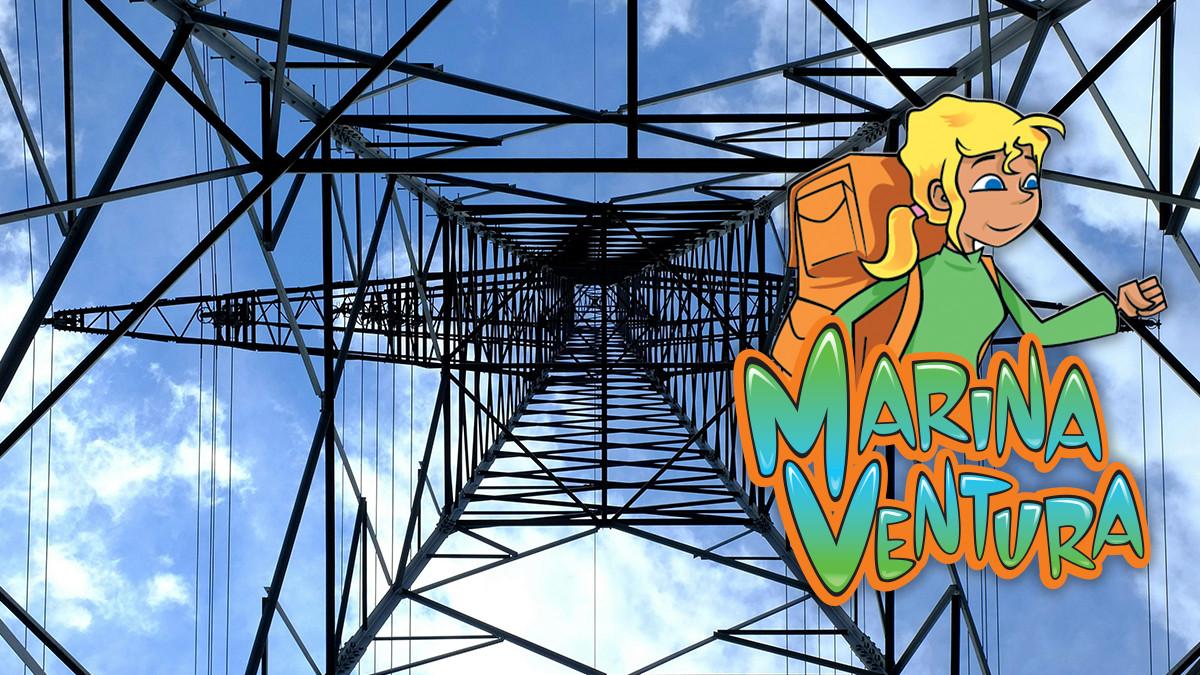
Hi guys! Marina Ventura here.
Map App and I are on a mission to explore the WHAT, HOW and WHY about the pylons that help carry electricity from where it’s produced to where’s its needed.
We want your help to come up with some cool designs for an electricity pylon of the future.
There’s lots to think about – it’s design, what it’s made of and how its built. So, join us as we find out what makes a perfect pylon!
The design
One of the most striking features of a pylon is – well, the way it looks and if it blends into its surroundings! So let’s dive into the design of these superstructures.
The design for many of the pylons we see today originated from a competition run by the Central Electricity Board in 1927.
The winning design was from the Milliken Brothers, an American engineering company.
Their design was a latticed A-frame structure, which was intended to be more delicate than the more brutalist structures being used in Europe and the United States.
It’s incredible to think that the basic latticed design has stayed remarkably the same for nearly 100 years!
Different types
When you think about pylons, you might think that they all look the same but they don’t.
There are many subtle variances – like how many levels of wires they have. Most have two or three levels.
They’re also structurally different depending on where in the chain of pylons they are.
Pylons at junctions have to be stronger because of the extra forces at play. There’s ones that cross river estuaries might be incredibly tall so that the cables remain high – even in the middle.
After all, tall ships might need to pass underneath.
Triangles
One thing that’s been consistent to date is the use of triangle shaped lattices and do you know why?
Triangles are one of the strongest shapes!
It’s not just in pylons that you’ll see lattices of triangles, they’re visible in many tall structures from skyscrapers to bridges, and not forgetting crane towers at construction sites!
So, strength is something to think about when designing your pylon although it can be quite fun to experiment with other shapes! Just maybe not a round shape.
Fun designs
Designers will want their design to look nice and fit into the landscape without messing up anyone’s view.
Some have even come up with fun ideas to make pylons part of the scenery.
In Iceland, they’ve used a design that makes pylons look like playing giants, whilst at Walt Disney World in Florida there’s a pylon shaped like Mickey Mouse’s head.

There have even been clown shaped pylons in Hungary and giant robot shaped ones in Brazil!

They sound rather fun. I wonder what shapes you’d come up with?
Designers also need to think about future developments when coming up with new designs, like where and how the grid connects as the number of power generators increases.
Did you know the first wind farms blew in to the UK in the early 1990s and today there are over 2,000 turbines generating over 20% of our electricity – many in rural areas of the countryside and even out at sea.
How high?
Pylons also have to be sky-high because they need to keep super high-voltage cables far from anything that could cause a shocking situation – like buildings, animals and of course humans!
Did you know:
- The standard pylon is about 120 feet tall – that’s like stacking twenty people on top of each other!
- The tallest pylons in the UK are near the River Thames and Botany Marshes in London – these electrical skyscrapers reach a staggering 623 feet – that’s taller than the BT Tower!
- The world record holder is a jaw-dropping giant in China at 1,246 feet.
Tall pylons mean the wires can easily straddle rivers, roads and railway lines. Now that’s electrifying!
Embed from Getty ImagesBut bigger doesn’t always mean better, especially when fitting pylons into the landscape or around built-up areas. You don’t want a pylon getting in the way of a plane!
T-Pylon
Whilst lattice structures are the bread and butter of pylons, designers are thinking of different styles…
The T-pylon is a new design being tested.
Rocking a T-shape and coming in 50 feet shorter than the old-school models, they still pack a punch with the ability to handle a whopping 400,000 volts.

36 of these futuristic pylons are already up and running in Somerset as part of a mega project to power up millions of homes with clean energy.
How cool is that!
It’s time to design
Why not get scribbling and start your design for a pylon of the future.
We want YOU to help come up with some cool designs for pylons of the future. Have a think about some of the important things to consider – how tall will it be, what’s its shape, how many cables will it hold.
We can’t wait to see your ideas! Send them to us here.
Watch Emma-Louise design a pylon below…
Listen to Marina Ventura Energy Explorer below!
Marina Ventura Energy Explorer is made with support from Grid for Good by the National Grid.





